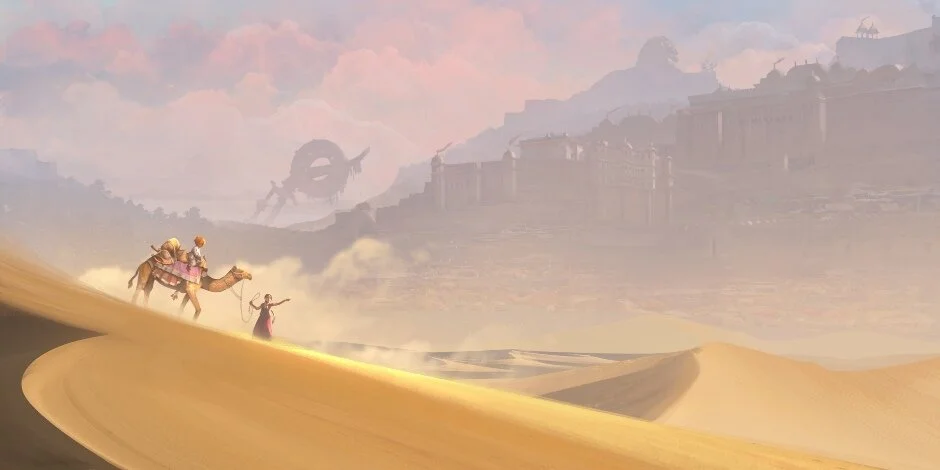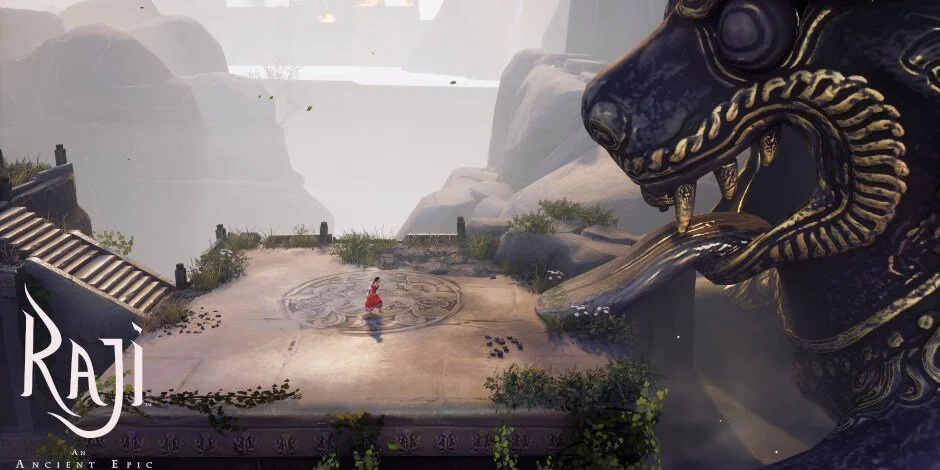After years of development and a lot of perseverance from Nodding Head Games, Raji: An Ancient Epic is here and players can experience this tale of Indian heroism and grand mythology.
I will say, it’s always exciting to see games release that showcase history and worlds that I’ve never seen before. There needs to be a wider array of titles that become available to gamers so that more of the world is reflected in the video game industry. So I’m happy that Nodding Head Games was able to make their dream a reality.
Raji: An Ancient Epic is an action-adventure game that features the eponymous heroine on a quest to find her brother. It’s full of epic fighting, searching, and ancient mythology. And it’s now for the Nintendo Switch, PlayStation 4, Xbox One, and PC via Steam.
STORY
Demons have attacked humanity in the midst of their conflict with the gods. Human cities fall, young and old are killed by the invaders, and darkness starts to sweep over the land. At the epicenter of this divine struggle are two humans, a little boy Golu, who is taken by the demons, and his sister Raji, who must rise up and fight.
This is where our story begins:
Raji and Golu are sister and brother who have been separated by the attacking demonic hordes and now find themselves in the middle of the great war. Raji has taken it upon herself to find her brother and put an end to this reckless war. However, this can only happen if she manages to break down the might and stratagem devised by the great lord of demons, Mahabalasura.
Raji’s response to this crisis and the quest she embarks on is the core of the game. It will be the focus of the divine narrators, Durga and Vishnu.
The outset of the game has a compelling narrative, but it eventually runs dry and is not taken seriously by the end of the game. What starts off strong ends with a cliffhanger and unanswered questions. For my first dive into Indian mythology and storytelling, Raji: An Ancient Epic leaves me dissatisfied and wanting more.
GAMEPLAY
Raji: An Ancient Epic quickly develops a simple pattern: move to a new area, fight demons in a close-quarter environment, and repeat until you reach a boss. Every now and then, that will be interrupted by a series of murals that depict some story in Indian mythology. Over all of these moments in the game lies an ever-present blanket of narration from the two gods that watch Raji as she searches for her brother.
At first, it’s endearing, but it will eventually start to tire the player out. Even with the short runtime of the game, that fatigue will settle in. Puzzles are few and far between, and when they appear they are simple enough that they stretch the definition of the word “puzzle.” Moving some cogs to a different spot. Or rotating concentric rings until an image emerges. Or rotating parts of a demonic tree until the pieces fit. It’s not very inspiring and it’s not enough to shake the rhythm of move, stop, attack, move, etc.
One of the most significant parts of Raji is the simplicity of the game. That could be a good or a bad thing depending on the player. The difficulty of the game really didn’t scale up at all, leaving me with the freedom to cruise through the game at a rather leisurely pace without encountering too many problems. I would die upon encountering new enemies or bosses, but then I’d quickly see what all the fuss was about and I’d adapt how I was going to attack. Then the fight was over and it was on to the next. So anyone looking for a challenge will not find it here. It’s a relaxed gaming experience.
All in all, Raji: An Ancient Epic is largely forgettable and I don’t think the gameplay will be something I dwell on by next week.
VISUALS
The visuals are easily the best part of the game. The cinematic sequences, which look like ancient stories told on fabric with dye and stitching, are charming. The world captivates you, even when the gameplay and the story leave you hoping for more. Everything about the setting and the environment is enchanting to me. It’s what kept me immersed in the game long after other aspects dwindled and disappeared.
I’m really impressed by what the artists, the graphic designers, and the developers were able to create here. It’s really pretty.
REPLAYABILITY
I see no reason why I would replay this game. The story disappoints and the combat doesn’t give enough variability or challenge to encourage players to try again. And the exploration is almost non-existent. There aren’t any collectibles. Or Easter eggs. Or anything that will draw players back to the experience.
It looks and feels like there is more to this game. But that’s just not the case.
In terms of hopping back in, the only positive thing that Raji has going for it is the game’s length. It’s short enough that players wouldn’t lose too much time if they started a new save file.
WHAT IT COULD HAVE DONE BETTER
For a short game, especially one that lasts less than ten hours, it’s very important what the gameplay highlights and how the story functions. If either of those two is weak—or if both are—then you’re going to have some problems.
Unfortunately, Raji slips up in both respects and it makes for a less meaningful gaming experience.
The gameplay suffers mostly in combat. It’s a linear game so there’s not a lot of exploration involved. That could be a critique in and of itself but I’m going to focus on what’s there since that alone has issues. Back to the combat. Over the course of the story, the young Raji will unlock four different weapons and fighting styles—the Trishul (a trident-like spear), a bow, a sword and shield, and the Chakra (a spinning disk that we’ll discuss in a moment). All of these have their merits, but they can also be imbued with the elemental powers of electricity, fire, and ice.
Raji: An Ancient Epic misses out on replay value, however, by only allowing one elemental power to be used at one time, which clashes with the availability of power slots in these elemental categories. You can find orbs throughout the game that strengthen elemental effects, but you can also remove these orbs and slot them into a different element if you want. It’s a strange system that never goes as far as it could. For example, having different weapons locked to certain elements throughout the game would have been interesting. So would being able to customize a mix of different elemental attacks depending on your distribution of the orbs. As is, it’s lackluster.
And the weapons are not made equal. The Chakra, which you get at the very end of the game, makes mincemeat of all demons that you face, including the final boss. It’s overpowered and it makes the final portion of the game a trivial affair that ends all too quickly. Just like the story.
Combat is weak overall, though. When I tried to experiment with the weapons and the combat styles, I would often die during those encounters. When I just spammed evasive and powerful attacks, however, it consistently resulted in Raji winning the fight with significant health remaining. Which begs the question, “Why would a player do anything else?”
Without spoiling what happens at the end of the game, the story also falls flat on its face. From the very beginning, it seems to assure the player that you’ll come away with a sense of why and how things are happening. That never happens, though, and you’re left with more questions than answers by the end of Raji. It’s a disappointing end to a game that really leans on its story as the backbone. When you discover that there’s nothing there in the end, you realize you’ve been leaning on a skeleton. There’s no meat on these bones.
VERDICT
Raji: An Ancient Epic opened with a lot of promise. I was intrigued by the cinematic sequences that told a tale of Indian mythology and heroism with dye and fabric. I enjoyed the female empowerment of the heroine Raji in a game that felt like a companion to Prince of Persia: The Sands of Time. The linear story had some exciting combat mechanics that were introduced by varied weapons. And it was not a game that I’d seen before. It was unique.
But, ultimately, that was not enough to save it. The narrative sequences started to rely on the same plot points for effect, weakening the overall story. The liberal use of Indian mythology—while initially appealing to someone who was unfamiliar with those stories—ends up taking away from the main narrative in an already short game. The combat can be frequently circumvented by spamming specific attacks rather than investigating when to use the right weapons and offensive styles on particular enemies. And the story, which is the beating heart of Raji, falters at the end in a rather stupendous fashion, leaving gamers unsatisfied and uncertain.
The potential was somewhat squandered, though it still leaves me hopeful that the indie developers can do better next time. For now, I’d skip it.


























